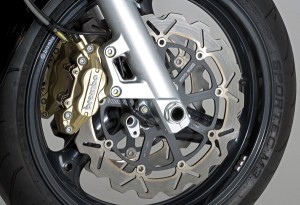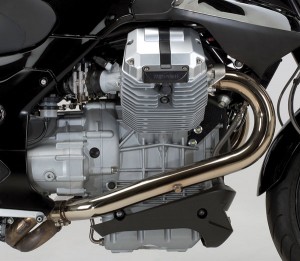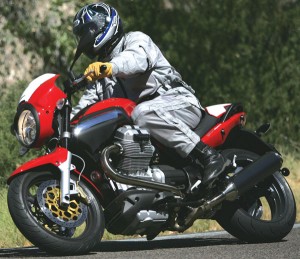It has been said that Moto Guzzi is rather like Italian politics: Every year there is a new government, but nothing really changes. For more than 40 years Guzzi has been developing its V-twin, with a 90-degree included angle, two overhead valves, and driveshaft-friendly longitudinal crankshaft, a new version seeming to appear every year. The big difference between the government and the Guzzi is that the Guzzi keeps getting better.
This latest rendition, the Breva 1200 Sport, is proof of that, as we found out during its Arizona introduction last September. Guzzi’s 703cc V7 first appeared back in 1967, and though there is certainly nothing interchangeable with the 1200 Sport’s 1,151cc version, it remains that essential pushrod twin. The 1200 uses the same engine as is bolted into the Norge (and the Breva 1200 not exported to the United States), with an oversquare bore of 95mm; stroke, 81.2mm; stampeding some 70-plus horses at 7,500 rpm. This engine is not really a low-rpm lugger, as it thrives on modest revs, with the maximum torque of about 60 lb-ft coming on at 6,000 rpm.
The headlight comes with a sporty little cowling, giving it a semblance of aerodynamics–this is not a top-speed machine, but one intended for happy speeds. At the bottom of the engine is a chin spoiler, aesthetically pleasing and also functional as it serves to protect the oil cooler.
The footpegs are slightly rear-set, and when the rider sits down (seat height is a shade over 31 inches, and a slightly lower saddle is an option), it is a long reach over the large six-gallon gas tank to the “advanced” handlebar –that is Guzzi’s word to describe the rather wide (almost 33 inches) solid-mounted Renthal bar, which suited my long torso and arms quite well. Those with a shorter reach might want to loosen the mounting bolts and turn the bar back 90 degrees. Two controls at the left end of the bar operate the computer on the dash, telling the rider most things that he might want to know, except which stock to buy.

The Marzocchi male-slider fork, 45mm in diameter, is adjustable for spring preload, compression and rebound damping, and has 4.7 inches of travel. The rake is 25 degrees; trail, 4.7 inches. The fork has been coated with an anti-friction compound called Tinalox. The Sachs shock absorber has preload and rebound adjustability, the rear wheel having 5.5 inches of movement.
Wheels are 17 inches, with a 120/70 tire on the front, 180/55 on the rear. The 320mm front discs use Brembo four-piston (opposed) calipers, the rear 298mm disc has a two-piston (parallel) caliper. ABS is an option for the Europeans, but not for Americans, as Moto Guzzi research shows that most sporting riders in this country are not interested in it.

The engine sits in a tubular-steel cradle frame, with 58.5 inches between the axles. The transmission has six speeds, with shaft final drive. Dry weight is said to be 506 pounds.
Turn the key, push the button, fuel is injected, two spark plugs in each cylinder fire the mixture, and the engine begins its leisurely side-to-side sway, so common with the longitudinal twins. Clutch in, first gear engaged, clutch released, and I am smoothly away. I like the ergonomics and the wide bar, making the Sport easy to maneuver out of the parking lot, and the saddle suits my butt. We settle in for some 80-mph freeway cruising out to Apache Junction, east of Phoenix, and then head off to the Apache Trail in the Tonto National Forest. Not that there is much forest out here, just rock and dirt and cactus.

I do enjoy that loping gait which all Guzzis have, not a frenetic rush to power that one feels in many higher-revving machines. A slight vibration comes through the bar and pegs, allowing the rider to keep his or her eyes on the road, rather than the tachometer. Which, on the Sport, has no painted redline, merely a red light on the face that blinks as the engine speed approaches the rev limiter, more easily noticed on a frolicsome ride than having to focus on the needle.
The Apache Trail is a superb road, two lanes of good pavement going up and down and around for many blissful miles, good Sport territory, endlessly clicking the shift lever through the gears, braking, throttling up, slowing, accelerating. The transmission is excellent, as are the brakes, and the ECU for the injectors seems right on, with no hesitations nor hiccups. The Sport seems very happy with my keeping the tach between five and seven thousand, and is intended for the leisurely rider, like myself, who likes a bit of lean, adequate power and comfort. I’m having fun without being crouched over and bent like a pretzel.

This was an all-too-short intro, as usual, and we hope to get a proper test machine, with all the optional touring accessories like saddlebags and heated grips, in the future. Already I would say that, having ridden many Guzzi models over the past 40 years, this has a fine engine and a fine chassis. Now Guzzi has to let the riding public know about it.








